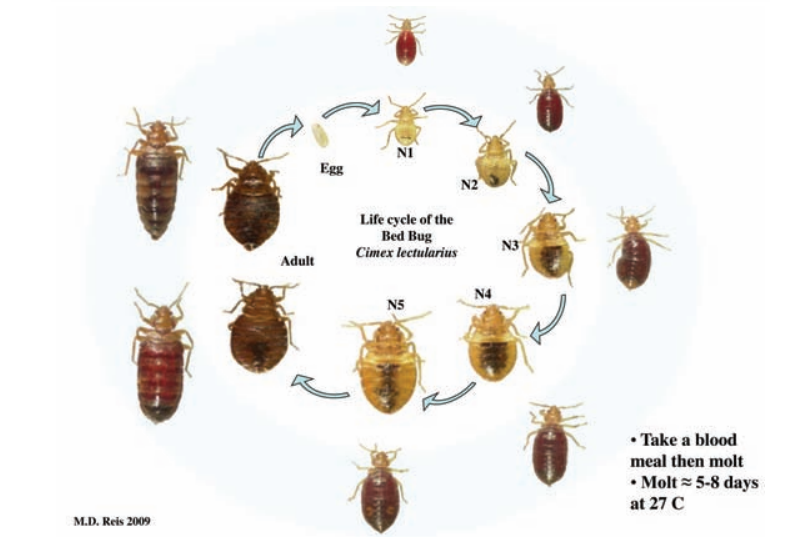Bed bugs don’t discriminate. They spread throughout single-family homes, summer camps, military encampments, and hotels alike. To treat infestations & prevent bed bugs from wreaking havoc on your establishment’s guests, it’s helpful to understand the bed bug life cycle.
Introduction to the Bed Bug Life Cycle
The bed bugs that are infesting homes today are the descendants of cave dwelling bugs that originally fed on the blood of bats. When humans began living in the caves, the bugs began feeding on humans. Later, when humans moved out of the caves and started their agricultural civilizations, the bugs moved with them. Since that time, humans have carried bed bugs all over the world.
Bed bugs belong to a family of insects called Cimicidae. All members of this family feed exclusively on blood. The common bed bug (Cimex lectularius) has five developmental life stages. Each immature life stage (called nymphs or instars) must take a blood meal in order to develop into the next life stage. Because bed bugs, like all insects, have their skeleton on the outside of their body (exoskeleton) they have to shed their exoskeleton in order to grow larger. This shedding of the exoskeleton is called molting. A bed bug nymph must take a blood meal to molt successfully. After growing through five instar molts, the bed bug becomes an adult. Adult bed bugs, both male and female, must also take regular blood meals to reproduce. The diagram above illustrates the bed bug life cycle including all instars, before and after feeding. The total development process from an egg to an adult can take place in about 37 days at optimal temperatures (>72° F). Adult bed bugs have a life span of nearly one year depending on regular access to blood meals and favorable temperatures.

Egg Production
The number of egg batches a female will produce in her lifetime is dependent on her access to regular blood meals. The more meals the female can take the greater the number of eggs she will produce. For example, the average adult female will live about one year. If she is able to feed every week, she will produce many more eggs in that year than if she is able to feed only once a month. On average:
- A female bed bug will produce between 1- 7 eggs per day for about 10 days after a single blood meal. She will then have to feed again to produce more eggs.
- A female can produce between 5 and 20 eggs from a single blood meal.
- The number of male and female eggs produced is about the same (1:1 ratio).
- A single female can produce about 113 eggs in her whole life.
- Eggs can be laid singly or in groups. A wandering female can lay an egg anywhere in a room.
- Under optimal conditions, egg mortality is low and approximately 97% of the bed bug eggs hatch successfully.
- At room temperature (>70° F), 60 percent of the eggs will hatch when they are 6 days old; >90 percent will have hatched by the time they are 9 days old.
- Egg hatch time can be increased by several days by lowering ambient temperature (to 50° F).
- Due to the large numbers of eggs a female can produce under optimal conditions (temperatures >70° F but < 90° F, and in the presence of a host), a bed bug population can double every 16 days.
Nymph Development Time
The time it takes any particular bed bug nymph to develop depends on the ambient temperature and the presence of a host. Under favorable conditions, such as a typical indoor room temperature (>70° F), most nymphs will develop to the next instar within 5 days of taking a blood meal. If the newly molted instar is able to take a blood meal within the first 24 hours of molting, it will remain in that instar for 5-8 days before molting again. At lower temperatures (50° F – 60° F), a particular instar may take two or three days longer to molt to the next life stage than a nymph living at room temperature. However, if a bed bug nymph does not have access to a host, it will stay in that current instar until it is able to find a blood meal, or it dies. The time for a bed bug to develop from an egg, through all five nymphal instars, and into a reproductive adult is approximately 37 days.
Even under the best conditions some bed bug nymphs will die prior to becoming adults. The first instars are particularly vulnerable. Newly hatched nymphs are exceptionally tiny and cannot travel great distances to locate a host. If an egg is laid too far from a host, the first instar may die of dehydration before ever taking its first blood meal. However, laboratory studies have found that overall bed bug survivorship is good under favorable conditions, and that more than 80 percent of all eggs survive to become reproductive adults.
Adult Bed Bug Life Span
The most recent studies indicate that a well-fed adult bed bug held at room temperature (>70° F), will live between 99 and 300 days in the laboratory. Unfortunately, we do not know exactly how long a bed bug might live in someone’s home or apartment. No doubt it will be at least several months. However, conditions are usually more challenging for the bed bugs living in human dwellings than they are in the laboratory (finding food, fluctuations in temperature and humidity, the presence of insecticides, avoiding being crushed, etc.) and these conditions will have a negative impact on bed bug survival.
A recent laboratory study has shown that starvation has a negative impact on bed bug survival. This modern study contradicts European studies conducted in the 1930s and 40s, when it was determined that bed bugs could survive periods of starvation lasting more than one year. While this may have been true for individual bed bugs in the UK living at very low temperatures (< 40° F; because of no central heating); modern bed bugs collected from homes in the United States do not live that long. On average starved bed bugs (at any life stage) held at room temperature will die within 70 days. Most likely these bed bugs are dying of dehydration, rather than starving to death. Because bed bugs have no source of hydration other than their blood meal, dehydration is the greatest natural threat to their survival while living in the indoor environment. In fact, one of the reasons that bed bugs pack themselves so tightly into small cracks and crevices is so that they can maintain a microhabitat of favorable temperature and humidity, thus increasing their ability to survive periods of starvation.
ESS Universal manufactures and supplies high-quality, cost-effective commercial grade furniture products. View our entire line of furniture products including our popular waterproof foam mattress for institutional use, single metal bed frames, single over single bunk beds, single over double bunk beds, and triple bunk beds.
This information is courtesy of Dini M. Miller, Ph.D. and Andrea Polanco, Department of Entomology, Virginia Tech. For additional information, read their full publication: Bed Bug Biology and Behavior.

